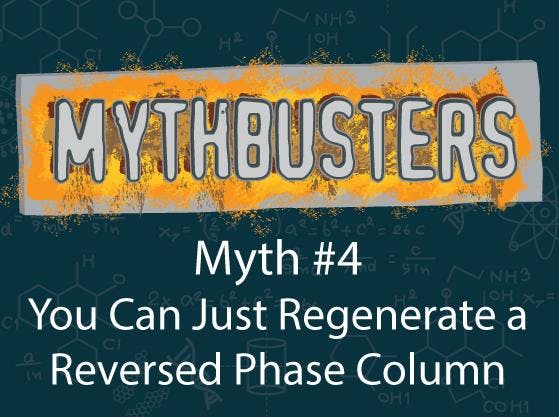
14 Feb 2022
MythBusters: SEC isn't possible if the column is too long
We’re on a roll with our MythBusting, debunking a wide selection of common misconceptions in the wider world of chromatography. Perhaps you think that regenerating a reverse phase column is a simple fix? Or that the humble vial is just a vial?

Well, today we’re looking into something that puts people off a particular technique. That technique is size exclusion chromatography (SEC)! And the myth? That you can’t practice SEC if a column is too long for the column oven you use.
Welcome back to Element MythBusters! Let’s get to the bottom of this one.
Myth: I can’t do SEC because the column is too long for my column oven
If you are new to size exclusion chromatography (SEC) you may be surprised that it is common to find methods that use 50 cm or longer columns. Many modern instruments have a column oven that will hold a column at a maximum length of 0.25 cm. At this point some may ask - is there anything that can be done to work around these instrument limitations? Do you even need to use a column oven anyway?
The fact that instrumentation features things like column ovens and pre-heaters suggests temperature control is rather important for liquid chromatography. But have you ever considered the reason why this is so critical? As we increase the temperature, we increase the chromatographic separation process which shortens our method. As a rule of thumb, for reversed-phase isocratic separation, you can predict a retention time decrease of 1-2% per 1 °C increase in column temperature [1]. Since the retention factors of all compounds in a sample are not affected equally, elution order may become inverted, or samples may co-elute with changes in temperature [1]. As a result, proper column temperature control is essential for separations, especially where there is marginal resolution of critical peak pair or if repeatable retention times are needed to identify individual sample compounds [2].
When considering an SEC or GPC column though, we need to consider that it is not a retentive separation mechanism. The separation mechanism ideally should be based only on the size of the analyte and is an entropy-driven process. The modified van ‘t Hoff expression shows that separation should be independent of temperature (equation 1-3) [2].

However, the temperature does affect the diffusion rate and solvent viscosity. The temperature may affect the structure and overall shape of the polymer or protein analyte being analysed [2]. Furthermore, it is very difficult to get an SEC separation where are no secondary interactions between the analyte and the column. Our aim is always to minimise these interactions to achieve as close to “no interaction” as possible, but secondary interactions will of course be affected by temperature. So, although SEC methods often simply state the temperature as “ambient”. Since ambient temperature could change by 10 °C or so during day/night in the lab, it is highly desirable to use a column oven to ensure good reproducibility. This is demonstrated well in Figure 1 [3].

Figure 1: Effect of temperature on an SEC separation. [3]
So, now we have established that temperature control is a must, let’s go back to the problem of needing to use a 50 cm column with a column oven that can only fit in a 30 cm column! One option could be to look at adapting your current instrument, potentially by using a different column oven or a custom column heating jacket. But let’s face it, if this is a one-off method then customising your HPLC may not be realistic.
A more attractive option may be to buy two 25 cm columns and join them together. Now, if you are used to working with reverse phase columns this may not be something you have considered. Joining two columns requires an additional piece of tubing to connect the columns, which in turn adds to the extra column volume in your instrument. The effects of extra column volume on your instrument are shown in figure 2. This example is from a UHPLC instrument where any extra column volumes can have a significant impact on your chromatography.

Figure 2: Impact of extra column volume on band broadening. [4]
Extra column volumes provide more space for the analyte band to diffuse, giving rise to band broadening [4]. This often leads to distortion of your peaks, where an increase in band broadening is seen for earlier eluting peaks (i.e., broader, less efficient peaks) as shown in Figure 2. This is the reason why we generally do everything we can to minimise extra column volumes such as keeping system tubing as short and narrow as possible. Unsurprisingly, joining two reverse-phase columns in series will generally give you worse chromatography than just using a longer column.
However, when we are dealing with SEC, relax about adding a little extra column volume. The reason for this is that SEC is inherently a low-resolution technique. The peak widths achieved will be much wider than for reverse phase chromatography anyway. We are aiming to have zero retention in an SEC method, so long columns are often unavoidable to improve resolution. Rather than using a long column, joining two shorter columns together so they will fit in your column heater can usually provide an acceptable solution with minimum impact to your chromatographic separation. In fact, sometimes joining SEC columns with different pore sizes can be joined together to increase the size separation range.
So, is it a myth that you can’t use a long SEC column if it doesn’t fit in your column oven? No, it is true that if you don’t want to make expensive customisations you can’t use a column that doesn’t fit in your instrument’s column oven. However, in the case of SEC, joining two shorter columns will usually give you a perfectly acceptable result instead.
We’re calling it! That’s another myth busted. Thanks for reading, and spread the word.
References
1. http://tools.thermofisher.com/content/sfs/brochures/WP-71499-LC-Temperature-Column-Thermostatting-WP71499-EN.pdf
2. https://www.chromatographytoday.com/article/size-exclusion-gel-permeation-chromatography-gpc/59/agilent-technologies/effects-of-secondary-interactions-in-size-exclusion-chromatography/2134
3. 3: Chromacademy, Developing SEC methods for Biologics analysis
4. Chromacademy, HPLC extra column volumes








